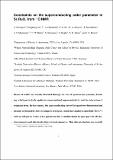Files in this item
Constraints on the superconducting order parameter in Sr2RuO4 from oxygen-17 nuclear magnetic resonance
Item metadata
| dc.contributor.author | Pustogow, A | |
| dc.contributor.author | Luo, Y | |
| dc.contributor.author | Chronister, A | |
| dc.contributor.author | Su, Y.-S | |
| dc.contributor.author | Sokolov, D | |
| dc.contributor.author | Jerzembeck, F | |
| dc.contributor.author | Mackenzie, Andrew Peter | |
| dc.contributor.author | Hicks, Clifford William | |
| dc.contributor.author | Kikugawa, N | |
| dc.contributor.author | Raghu, S | |
| dc.contributor.author | Bauer, E | |
| dc.contributor.author | Brown, S | |
| dc.date.accessioned | 2020-03-23T00:33:13Z | |
| dc.date.available | 2020-03-23T00:33:13Z | |
| dc.date.issued | 2019-10-03 | |
| dc.identifier | 261126322 | |
| dc.identifier | 40f9eaa7-c382-4d94-b681-5212f9328885 | |
| dc.identifier | 85072943309 | |
| dc.identifier | 000488832500032 | |
| dc.identifier.citation | Pustogow , A , Luo , Y , Chronister , A , Su , Y -S , Sokolov , D , Jerzembeck , F , Mackenzie , A P , Hicks , C W , Kikugawa , N , Raghu , S , Bauer , E & Brown , S 2019 , ' Constraints on the superconducting order parameter in Sr 2 RuO 4 from oxygen-17 nuclear magnetic resonance ' , Nature , vol. 574 , no. 7776 , pp. 72–75 . https://doi.org/10.1038/s41586-019-1596-2 | en |
| dc.identifier.issn | 0028-0836 | |
| dc.identifier.uri | https://hdl.handle.net/10023/19694 | |
| dc.description.abstract | Phases of matter are usually identified through spontaneous symmetry breaking, especially regarding unconventional superconductivity and the interactions from which it originates. In that context, the superconducting state of the quasi-two-dimensional and strongly correlated perovskite Sr2RuO4 is considered to be the only solid-state analogue to the superfluid 3He-A phase1,2, with an odd-parity order parameter that is unidirectional in spin space for all electron momenta and breaks time-reversal symmetry. This characterization was recently called into question by a search for an expected ‘split’ transition in a Sr2RuO4 crystal under in-plane uniaxial pressure, which failed to find any such evidence; instead, a dramatic rise and a peak in a single-transition temperature were observed3,4. Here we use nuclear magnetic resonance (NMR) spectroscopy of oxygen-17, which is directly sensitive to the order parameter via hyperfine coupling to the electronic spin degrees of freedom, to probe the nature of superconductivity in Sr2RuO4 and its evolution under strain. A reduction of the Knight shift is observed for all strain values and at temperatures below the critical temperature, consistent with a drop in spin polarization in the superconducting state. In unstrained samples, our results contradict a body of previous NMR work reporting no change in the Knight shift5 and the most prevalent theoretical interpretation of the order parameter as a chiral p-wave state. Sr2RuO4 is an extremely clean layered perovskite and its superconductivity emerges from a strongly correlated Fermi liquid, and our work imposes tight constraints on the order parameter symmetry of this archetypal system. | |
| dc.format.extent | 11 | |
| dc.format.extent | 112969 | |
| dc.language.iso | eng | |
| dc.relation.ispartof | Nature | en |
| dc.subject | QC Physics | en |
| dc.subject | T Technology | en |
| dc.subject | DAS | en |
| dc.subject | BDC | en |
| dc.subject | R2C | en |
| dc.subject.lcc | QC | en |
| dc.subject.lcc | T | en |
| dc.title | Constraints on the superconducting order parameter in Sr2RuO4 from oxygen-17 nuclear magnetic resonance | en |
| dc.type | Journal article | en |
| dc.contributor.institution | University of St Andrews. Condensed Matter Physics | en |
| dc.contributor.institution | University of St Andrews. School of Physics and Astronomy | en |
| dc.identifier.doi | https://doi.org/10.1038/s41586-019-1596-2 | |
| dc.description.status | Peer reviewed | en |
| dc.date.embargoedUntil | 2020-03-23 |
This item appears in the following Collection(s)
Items in the St Andrews Research Repository are protected by copyright, with all rights reserved, unless otherwise indicated.

